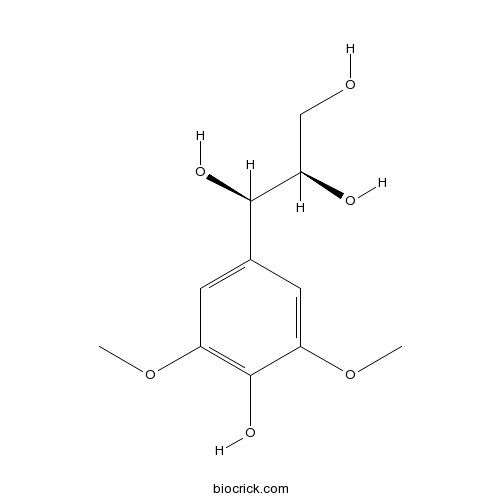threo-1-C-SyringylglycerolCAS# 121748-11-6 |

Quality Control & MSDS
3D structure
Package In Stock
Number of papers citing our products

| Cas No. | 121748-11-6 | SDF | Download SDF |
| PubChem ID | 14237630 | Appearance | Cryst. |
| Formula | C11H16O6 | M.Wt | 244.2 |
| Type of Compound | Phenylpropanoids | Storage | Desiccate at -20°C |
| Solubility | Soluble in Chloroform,Dichloromethane,Ethyl Acetate,DMSO,Acetone,etc. | ||
| Chemical Name | (1R,2R)-1-(4-hydroxy-3,5-dimethoxyphenyl)propane-1,2,3-triol | ||
| SMILES | COC1=CC(=CC(=C1O)OC)C(C(CO)O)O | ||
| Standard InChIKey | GIZSHQYTTBQKOQ-GMSGAONNSA-N | ||
| Standard InChI | InChI=1S/C11H16O6/c1-16-8-3-6(10(14)7(13)5-12)4-9(17-2)11(8)15/h3-4,7,10,12-15H,5H2,1-2H3/t7-,10-/m1/s1 | ||
| General tips | For obtaining a higher solubility , please warm the tube at 37 ℃ and shake it in the ultrasonic bath for a while.Stock solution can be stored below -20℃ for several months. We recommend that you prepare and use the solution on the same day. However, if the test schedule requires, the stock solutions can be prepared in advance, and the stock solution must be sealed and stored below -20℃. In general, the stock solution can be kept for several months. Before use, we recommend that you leave the vial at room temperature for at least an hour before opening it. |
||
| About Packaging | 1. The packaging of the product may be reversed during transportation, cause the high purity compounds to adhere to the neck or cap of the vial.Take the vail out of its packaging and shake gently until the compounds fall to the bottom of the vial. 2. For liquid products, please centrifuge at 500xg to gather the liquid to the bottom of the vial. 3. Try to avoid loss or contamination during the experiment. |
||
| Shipping Condition | Packaging according to customer requirements(5mg, 10mg, 20mg and more). Ship via FedEx, DHL, UPS, EMS or other couriers with RT, or blue ice upon request. | ||

threo-1-C-Syringylglycerol Dilution Calculator

threo-1-C-Syringylglycerol Molarity Calculator
| 1 mg | 5 mg | 10 mg | 20 mg | 25 mg | |
| 1 mM | 4.095 mL | 20.475 mL | 40.95 mL | 81.9001 mL | 102.3751 mL |
| 5 mM | 0.819 mL | 4.095 mL | 8.19 mL | 16.38 mL | 20.475 mL |
| 10 mM | 0.4095 mL | 2.0475 mL | 4.095 mL | 8.19 mL | 10.2375 mL |
| 50 mM | 0.0819 mL | 0.4095 mL | 0.819 mL | 1.638 mL | 2.0475 mL |
| 100 mM | 0.041 mL | 0.2048 mL | 0.4095 mL | 0.819 mL | 1.0238 mL |
| * Note: If you are in the process of experiment, it's necessary to make the dilution ratios of the samples. The dilution data above is only for reference. Normally, it's can get a better solubility within lower of Concentrations. | |||||

Calcutta University

University of Minnesota

University of Maryland School of Medicine

University of Illinois at Chicago

The Ohio State University

University of Zurich

Harvard University

Colorado State University

Auburn University

Yale University

Worcester Polytechnic Institute

Washington State University

Stanford University

University of Leipzig

Universidade da Beira Interior

The Institute of Cancer Research

Heidelberg University

University of Amsterdam

University of Auckland

TsingHua University

The University of Michigan

Miami University

DRURY University

Jilin University

Fudan University

Wuhan University

Sun Yat-sen University

Universite de Paris

Deemed University

Auckland University

The University of Tokyo

Korea University
- NAS-181
Catalog No.:BCC7056
CAS No.:1217474-40-2
- (+)-UH 232 maleate
Catalog No.:BCC6790
CAS No.:1217473-50-1
- Isochandalone
Catalog No.:BCN4767
CAS No.:121747-90-8
- Isoderrone
Catalog No.:BCN3698
CAS No.:121747-89-5
- Ro 26-4550 trifluoroacetate
Catalog No.:BCC5813
CAS No.:1217448-66-2
- VD2-D3
Catalog No.:BCC2034
CAS No.:1217448-46-8
- A 350619 hydrochloride
Catalog No.:BCC5939
CAS No.:1217201-17-6
- CP 31398 dihydrochloride
Catalog No.:BCC2406
CAS No.:1217195-61-3
- 6-O-p-Methoxycinnamoylcatalpol
Catalog No.:BCN6109
CAS No.:121710-02-9
- GYKI 47261 dihydrochloride
Catalog No.:BCC7566
CAS No.:1217049-32-5
- BU 239 hydrochloride
Catalog No.:BCC5668
CAS No.:1217041-98-9
- PTC209 HBr
Catalog No.:BCC5640
CAS No.:1217022-63-3
- BYL-719
Catalog No.:BCC3707
CAS No.:1217486-61-7
- SB 205607 dihydrobromide
Catalog No.:BCC5687
CAS No.:1217628-73-3
- SB 258719 hydrochloride
Catalog No.:BCC5937
CAS No.:1217674-10-6
- RS 16566 dihydrochloride
Catalog No.:BCC6890
CAS No.:1217788-97-0
- 5-Iodo-A-85380 dihydrochloride
Catalog No.:BCC7099
CAS No.:1217837-17-6
- Ac-Trp-OH
Catalog No.:BCC3109
CAS No.:1218-34-4
- Xylometazoline HCl
Catalog No.:BCC4879
CAS No.:1218-35-5
- Pidotimod
Catalog No.:BCC4823
CAS No.:121808-62-6
- CAY10505
Catalog No.:BCC4990
CAS No.:1218777-13-9
- LDE225 Diphosphate
Catalog No.:BCC1693
CAS No.:1218778-77-8
- GKT137831
Catalog No.:BCC5460
CAS No.:1218942-37-0
- Dorsomorphin 2HCl
Catalog No.:BCC4361
CAS No.:1219168-18-9
Chemical constituents from branch of Fraxinus sieboldiana.[Pubmed:26697686]
Zhongguo Zhong Yao Za Zhi. 2015 Jul;40(13):2602-11.
Using a combination of various chromatographic techniques including column chromatography over silica gel, Sephadex LH-20, macroporous adsorbent resin, and reversed-phase HPLC, 115 compounds including diterpenes, sesquiterpenes, treterpenes, coumarins, lignans, fatty acid derivatives, and simple aromatic derivatives were isolated from an ethanol extract of branch of Fraxinus sieboldiana (Oleaceaue), and their structures of the compounds were elucidated by spectroscopic methods including 1 D, 2D NMR and MS techniques. Among them, 41 compounds were new. In previous reports, we have been described the isolation, structure elucidation, and bioactivities of the 41 new compounds and 22 known orii including 8 coumarins, 4 phenolic and 12 phenylethanoidal glycosides. As a consequence, we herein reported the isolation and structure elucidation of the remaining 50 known compounds including 8- hydroxy-12-oxoabieta-9(11),13-dien-20-oic 8, 20-lactone(1), 6beta-hydroxyfcrruginol(2),(+)-pisiferic acid(3), (+)-pisiferal(4),(+)-7-dehydroabiet6none(5), 1-oxomiltirone(6), subdigitatone(7), linarionoside B(8), (9S)-linarionoside B(9), (3R,9R)-3-hydroxy-7,8-dihydro-beta-ionol 9-O-beta-D-apiofuranosyl-(1-->6)-beta-D-glucopyranoside(10), ursolic acid(11), betulinic acid(12), euscaphic acid(13), (+)-syringaresinol(14), (+)-fraxiresinol(15), (+)-1-hydroxysyringaresinol(16), pinoresinol(17), medioresinol(18), 8-acetoxypinoresinol(19), epipinoresinol(20), (-)-olivil(21), (+)-cyclo-olivil(22), 3,3'-dimethoxy-4,4',9-trihydroxy-7,9'-epoxylignan-7'-one(23),(+)-1-hydroxypinores inol 4'-O-beta-D-glucopyranoside (24), (+)-1-hydroxypinoresinol 4"-O-beta-D-glucopyranoside(25),(+)-syringaresinol O-beta-D-glucopyranoside (26), liriodendrin (27), ehletianol D(28), icariside E5(29) (-)-(7R, 8R)-threo-1-C-Syringylglycerol(30),(-)-(7R, 8S)-erythro-guaiacylglycerol (31),(-)-(7R, 8R)-threo-guaiacylglycerol(32), 3-(4-beta-D-glucopyranosyloxy-3-methoxy)-phenyl-2E-propenol(33),2,3-dihydroxy-l-( 4-hydroxy-3,5-dimethoxyphenyl)-1-propanone(34), 2,3-dihydroxy-1-(4-hydroxy-3-methoxyphenyl)-1-propanone (35), 3-hydroxy-l-(4-hydroxy-3,5-dimethoxyphenyl)-1-propanone(36), omega-hydroxypropioguaiacone(37), sinapyladehyde(38), trans-p-hydroxycinnamaldehyde(39), syringic acid(40), vanilic acid(41), vanillin(42), 4-hydroxy-benzaldehyde (43), (24R)-24-ethyl-5alpha-cholestane-3beta,5,6beta-triol(44), beta-sitosterol(45), daucosterol(46), 2,6-dimethoxy-I,4-benzoquinone(47), 2,6-dimethoxy-pyran-4-one(48), 1-(beta-D-ribofuranosyl)uracil(49), and mannitol(50). Compouds 1-7,12,18,28-37,44 and 48 were obtained from the genus Fraxinus for the first time.


